This dance is included in the repertoire of the State Ensemble for folk songs and dances—Sofija.
The dance is performed accompanied by one gŭdulka playing music in 2/4 and 9/8.
The basic movements of this dance are: a small, quick walking step done on the heels, a running step, small jumps and “čukče-s” with very rich rhythmic variation. As well as by themselves, these basic movements also occur in combinations with each other or with turning and leg lifts. The most common foot position in the dance is second, and after that sixth /parallel/ and first.
Starting position of the feet—sixth position, toes slightly off the ground, weight of the body is on the heels. The knees are straight, the movement of the legs is from the pelvic-thigh joint. Performed in half measures.
l—small step with the R foot forward (the heel comes to the middle
of the L foot).&—the same with the L foot.In one measure, therefore, there are four almost sliding little steps forward, alternating R and L feet.
With this movement the dolls usually move from one place to the other in all directions forwards and backwards, in a straight line or in a circle.
This movement is the same as the one above, except that the steps are wider and slower, i.e. one step per beat (two steps per measure), or even more lengthened, one step per measure. This movement occurs less often in the dance.
The čukče is a movement that comes from rising onto half-toe (low or high), always on “&” before the measure beat and then immediately lowering (on the measure beat) onto the whole foot as the heel accents.
The movement comes from the ankles only.
Starting position— sixth /parallel/.
The čukče may be in various rhythms, and depending on that to differentiate them, we shall call them: single čukče, double čukče and triple čukče in 2/4 time; quadruple čukče and slow čukče in 9/8 time.
1—čukče&—rest2—rest&—rest1—čukče&—rest2—čukče&—rest1—čukče&—čukče2—čukče&—rest1—čukče2—čukče3—čukče4—rest1—čukče2—rest3—čukče4—restOne of the most frequent movements in the dance is the čukče. As well as by itself, it is used in combination with steps, turning and spinning. The jerky character of the dance comes from the various čukče-s.
The čukče-s in the dance are done in sixth, second and first position on both feet at the same time or on one foot.
The podskokče is a movement with many different forms. In the dance “Kukli” it is very close to the movement “čukče”. The difference is that instead of rising onto the toes there is a high or low jump. Similar to the čukče, it is in various rhythms which we will refer to in the same way: single, double, triple, etc. In general, everything said about the čukče may be said about the podskokče.
This movement, when repeated consecutively comes only from the ankles. But in order that the first podskokče may be made, there is a very slight bending of the knees so that there will be no strain to other joints and muscles.
Starting position— sixth /parallel/.
Done with straight knees and on the heels—the toes are slightly off the floor. The movement of the legs comes from the pelvic-thigh joint.
& before the measure— R leg is raised in the air forward and
low.
1—jump onto R heel next to L, at the same time the L foot is lifted
forward and low.&—step with L onto heel next to middle of R foot.2—same as “&” from 1, but with R foot.&—same with L foot3—same with R foot&—same with L foot4—same with R foot&—same with L foot, but R foot is lifted forward as in “&”
before the measureThis movement is basic for male doll I, which he uses for moving in all directions in the dance.
Starting position—feet in sixth or second position, arms are extended down slightly to the side of the body and forward.
l—čukče on both feet. Body and arms turn 45º to the right.2—čukče on both feet.3—čukče on both feet. Body and arms turn 45º to the left.4—as 1.In this movement the arms, in whatever position they are, bounce sharply up and down in rhythm to the čukče.
This movement is performed by the two female dolls who are one behind the other for the first four measures.
Starting position—feet in second position, arms strongly extended down and slightly out. Done in eight measures.
1—accented step with the heel of the R leg forward (Photo 1).&—step in place with the L foot.2—step with full R foot in place.&—restl—čukče with R foot, simultaneously lifting L foot high straight
forward, the body leans back and to the right, and the arms are raised high above (Photo 2).&—rest.2—čukče with R foot, L foot sharply returns to second position,
arms also swing sharply down into starting position.&—rest.l—čukče with L foot, and R foot is lifted in the air to the side,
simultaneously turning one quarter on the L foot to the L (with R shoulder leading) (Photo 3).[2—čukče s levjata krak, a desnijat stŭpva vŭv vtora pozicija.]
[2—čukče on L foot, and R steps into second position.]l—čukče on both feet in second position.2—same as 1.Photo 1
|
Photo 2
|
Photo 3
|
|
Starting position—second. Performed in four measures.
1—jump onto R heel forward.&—step with L foot onto heel to the middle of R foot.2—same as 1, but forward and slightly to the R.&—same as “&” after 1.1—jump back onto R foot, L foot lifted in the air forward, as in Photo 2.2—step with L foot to second position.&—rest.The movement comes from jumping in the air and turning simultaneously, either 180º (half turn) or 360º (full turn).
Starting positions for various situations include: sixth with slightly bent knees, second in demi-plié, and first position in grand plié.
This movement is combined most often in the dance with čukče-s and jumps /podskokče/.
This movement is performed only by the two female dolls.
Starting position—feet in second position, arms are extended down and out, head is turned in the direction of turning, and the eyes must focus on a point eye level at a distance in the direction of movement (movement is lateral). While turning, on each beat the arms are brought vigorously to the body (rowing motion), and on “&” of every beat they open up to the side (jerking up) to starting position. The movement of the arms helps to turn.
The “vŭrtene po spirala” is performed in eight measures. It consists of consecutive half turns in the given direction for seven measures (two per measure) and in the final measure, a double turn in place on the R foot, the L foot bent at the knee raised high forward.
“&” before the measure—raise onto L toes, R foot lifted from the floor,
arms raise up, half turn to L with R shoulder leading.1—step with both feet onto full foot in second position, arms drop
down (Photo 4a).&—rise onto R toes, L foot lifted from floor, at the same time
a half turn to the L (with L shoulder following). Arms open up to the side (Photo 4b).2—as 1&—as “&” after 1, but with opposite foot, turning to L
with L shoulder following1—step with R foot on toes crossing in front of L foot, at the same time with a
vigorous turn to the L. In the eighth measure two turns are made (two 360º turns). The
step is completed in narrow second position.Photo 4a
|
Photo 4b
|
During the dance the dolls’ arms occur in various significant positions and movements, as well as emphasize the rhythm of the “čukče” and the “podskokče”. Below are the most characteristic arm movements.
The movement is performed by the two female dolls, standing in sixth position one facing the other. The arms are bent at the elbow so that the upper arm is held to the body and the lower arm forms a right angle with it. The hand forms a fist with the forefinger pointing forward (Photo 5). The movement of the arms is combined with čukče-s. Performed in two measures.
1—čukče on both feet, body turns 1/2 to the L, the R arm,
straightening a little at the elbow, makes a sharp movement forward as if in reprimand:
“you [are to blame]!”.2—rest1—čukče on both feet, body turns to L, L arm “pokes” (see
Meas. I) forward and the R arm returns to starting position.2—rest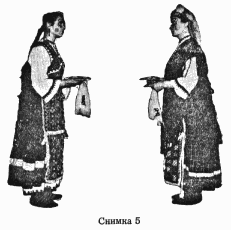
The movement in character and starting position is the same as the one above. Performed in 16 measures.
1—čukče on both feet, body turns to L, bent slightly forward; R
arm “pokes” forward.2—rest.l—čukče on both feet, body turns to R, L arm “pokes” forward.
R arm returns to starting position.2—čukče on both feet, body turns to L, R arm “pokes” forward.
L arm returns to starting position.&—R arm returns (not completely) to starting position. Body
faces forward.l—čukče on both feet. Body turns L, R arm “pokes” forward2—čukče on both feet. Body turns R, L arm “pokes” forward. R
arm returns to starting position.l—čukče on both feet, body straightens and bends slightly
backwards, L hand goes to the waist and R hand opens palm—as if threatening
to slap (Photo 6).2—restl—čukče on both feet, body leans forward and slightly to the L, L
hand “hits” with the palm (without moving the wrist) in the air forward and down (Photo 7).The following eight measures are the same as the first eight, except that the fifth is done with the opposite hand, “hitting” with the L hand, with the R hand on the waist.
Photo 6
|
Photo 7
|
This movement is performed only by the two female dolls. It consists of waving both arms first to the right, then to the left, combined with čukče-s.
Starting position—feet in second position, arms are extended downwards, almost parallel to each other. Performed in four measures.
On “&” before the measure—rising onto half-toe, body turns to R,
slightly bent [backward], and the arms are raised up slightly (Photo 8).1—step onto whole foot, arms swing down.[&—povdigane na polupalci i sŭštevremenno rŭcete se povdigat
nagore.]
[&—rising onto half-toe, at the same time arms are raised up.][2—sŭšto kakto na “raz”.]
[2—same as 1][&—tjaloto i rŭcete se obrŭštat polunaljavo. Rŭcete se
povdigat nagore, a tjaloto leko se naklonjava nazad, sŭštevremenno povdigane na
polupalci.]
[&—body and arms turn to L. Arms raise up and body leans back slightly,
at the same time raising onto toes.]1—same as 1, Measure I.&—same as second “&” of Measure I (to the L).2—same as 1.&—same as first “&” of this measure, but to R.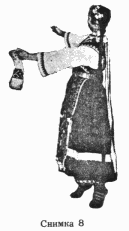
From the downstage R wing, the gŭdulka player enters with a small stool. He heads for the R downstage corner, sits on the stool and begins to play. The first two measures are a prelude as we wait for the dolls, who are offstage.
[Editor's Note: the symbols used to depict the male and female dolls may be confusing without a frame of reference as to their proper assignment and orientation. Figure 0 provides such a reference.]
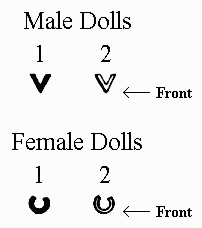
Measures 1-10. The two female dolls, of which I is behind the L upstage wing and II is behind the R one, head towards each other with some hostility with movement 1 “Siten hod,” which takes up 7 measures. On “1” of the eighth measure, as they raise onto half-toe, they step sharply into second position, closely facing each other, very slightly bent forward. Their arms are extended down and slightly out from the body. On “2”—rest. On “1” of the ninth measure, a čukče on the R foot while turning L (half circle), and as their backs are to each other, on “2” they step into second position.(Figure 1). Measure 10—rest.
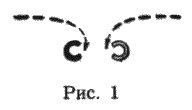
Measures 11-28. As they shake jerkily the two dolls move with movement 1 “Siten hod,” which takes up 14 measures as they move along the path described in Figure 2. In Measure 25, on “1” from a čukče on the L foot they step sharply onto flat feet in second position facing each other. On “2”—rest. In Measure 26 they do the same, except that the čukče is done on the R foot with a simultaneous half turn, so that on “1” they step into second position one towards the other. Measure 27—rest. Measure 28—they do the same, but turn to face one another, and the arms raise up and bend at the elbows (Photo 5). These sharp turnings, jerkiness and shakiness of bodies and arms show that the two “women” are on bad terms as they hurl insults at each other.
Measures 28-44. Standing facing each other, the two “women” continue to make “accusations”. They perform movement 12 “Dvojno boc” (photos 5 and 6).
Measures 45-52. With movement 1 “Siten hod,” arms placed in front of the stomach (elbows out from the body), in the same mood the two dolls approach one another very close face to face and turn around each other (Figure 3).
Figure 2
|
Figure 3
|
Measures 1-4. The two female dolls, having expressed their hostility, turn back to back and head off in opposite directions with movement 5 “Pritičvane” using two measures, and when on the fourth beat of the second measure they hear that someone is coming, they turn curiously facing center stage and step from a čukče to second position, leaning forward. The next two measures they stand in place (Figure 4).
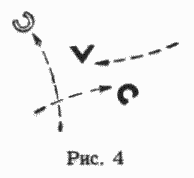
Male doll I with movement 5 “Pritičvane” using three measures enters (swaggering) from the L upstage wing and heads toward the two dolls along a diagonal line toward the center of the stage. In the last measure with a čukče on the R foot he steps into second position facing the audience (Figure 4).
Measures 5-8. The male doll on “1” of Measure 5 turns with a čukče on the R foot toward female doll I and stands in sixth position, saluting her with his R hand. Measure 6—rest. Measure 7—with a čukče on the R foot he turns (to L) facing female doll II, stands in sixth position and salutes her with his L hand. Measure 8—rest (Photo 9).
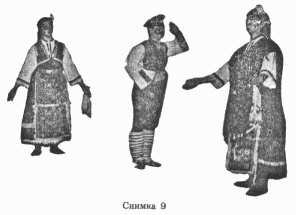
Female doll I, flattered by the “sergeant’s” attention begins to dance. In two measures, straightening a little, she performs movement 6 “Podrusvane” twice. In the next measure, neglected by her wooer, on “1” and “2” she rises high onto the toes of her R foot and turns a little to the R, the L foot is lifted forward and to the side. On “3” she steps into second position (L foot slightly forward) and leans forward. Measure 8—rest (Photo 9).
Female doll II stands two measures in place and observes the other two dolls. In the following two measures, drawn attentively to the male doll, she coquettishly performs movement 6 “Podrusvane” (Photo 9).
Measures 9-20. Female doll II continues to “dance”. For two measures she does a “slow čukče” on the L foot, the R foot is raised to the side and at the same time she does quarter turns to the L and describes a circle around herself. On the third measure she sees that the sergeant has once again directed his attention to the other doll; she stops dancing and watches them jealously. This happens as on “1” with a čukče on the L foot she steps into a wide second position and leans forward half turned toward the other dolls. For the next 7 measures—rest (in the same position). In the second to last measure she tries to attract the attention of the male doll as he moves toward her with movement 5 “Pritičvane,” and in the last measure with the same movement she turns around and returns to her place (Figure 5).
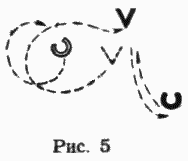
The male doll, in the same position, saluting female doll II, stands another two measures. In the third measure with a čukče on the R foot he turns toward female doll I and stands in sixth position. He salutes with the other hand. For the next six measures he “dances” in front of female doll I: for three measures he performs movement 6 “Podrusvane”. The next measure with a small jump he makes four half turns in the air to the L. For one measure he performs movement 6 “Podrusvane” and for one more measure four small jumps, turning halfway to the R. For the next three measures with movement 5 “Pritičvane,” as if clapping his hands in front of his chest, he heads off in a circle to the R, circling with female doll I. In the last measure he stops and “stares”at female doll II, who is approaching her in a challenging manner (Figure 5).
Female doll I stands two measures in place. In the next 6 measures she “dances” before the “sergeant” who once again has turned towards her. She does the same movements as the male doll. For the last 4 measures—circling and clapping in a circle to the R with the male doll. The movements are the same as the male doll’s, without stopping on the last measure (Figure 5).
Measures 21-28. Female doll II from a čukče on the L foot stands in second position and stays there for two measures. In the next two measures she performs “Quadruple jumping” /Četvorno podskokče/ twice in place, facing the audience. For the next 4 measures she does a “slow čukče”on the L foot, the R foot resting on the toes to the side (second position), and at the same time she turns quarter turns to the L as she describes two circles around herself.
The male doll circles female doll II for 8 measures with movement 5 “Pritičvane” (Figure 6).
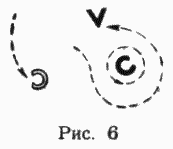
Female doll I stands 6 measures in place and observes the other dolls with growing jealously. In the seventh measure she loses her patience and with movement 5 “Pritičvane” she turns jerkily to face the audience and then heads forward. In the eighth measure on “1” and “2” she rises tall onto the toes of her L foot and turns to face the other female doll, L leg is raised forward and slightly to the side. On “3” she steps sharply into a not too wide second position, her arms bend forward at the elbows, with pointed forefingers (Photo 5), at the same time she leans forward slightly (Figure 6).
Measures 1-8. Female doll I, “hurling sharp insults” performs movement 11 “Boc” for 7 measures, facing female doll II. In the eighth measure she bends her arms in front of the stomach, elbows sticking out.
Female doll II-four measures rest. She “listens”with growing indignation. The next 3 measures she performs movement 11 “Boc” facing the other doll. In the eighth measure she bends her arms in front of her stomach (elbows sticking out).
Male doll I-four measures rest. Surprised by the unexpected arguing of the two “women,” he observes from the side. For the next two measures with movement 2 “Razreden hod” (one step per measure), he steps back a little. In the last two measures he turns to face stage R and with the same step starts to “take his leave”.
Measures 9-24. Female doll II runs towards I and they almost come to blows. This is performed with movement 1 “Siten hod”, hands on the stomach. The quarreling is expressed as the dolls stand very close face to face, turning together in a spiral towards stage L. Their bodies bow jerkily and with their heads they “peck” at each other on certain beats in the measure. All of this is performed in 16 measures. Female doll II first “pecks” (the head is sharply bent forward and immediately straightened) on the second beat of the second measure, then female doll I on the first beat of the third measure, and after that both together on the second beat of the fourth measure. Care must be taken not to hit heads, therefore they must bow forward and a little to the side. This pattern is repeated four times (photo 10).
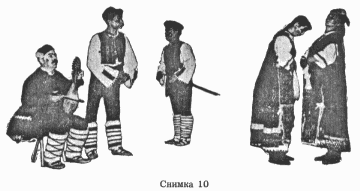
The male doll with movement 2 “Razreden hod” for 12, as he alternately turns with his whole body to watch the quarreling dolls and continues his path, heads toward the R upstage wing. In the thirteenth measure he stops with his back almost to the audience in second position and stands in position three more measures (photo 10).
In the last measure with movement 1 “Siten hod” male doll II (the kaval player) enters from the downstage R wing with a kaval in his hands. Leaning forward in second position, he looks questioningly at the quarreling dolls as if to ask, “why are they quarreling?” (Photo 10).
“You’ve argued enough! Listen to me play for you!” The “kaval player”, having decided to separate them, puts the kaval to his lips and begins to “play” a short, measureless melody. Playing, he makes his way with wide steps towards the two female dolls and stops center stage facing the audience. Stopping in second position, he plays his melody (Figure 7).
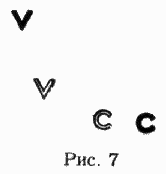
As the “kaval player” begins to play the two female dolls, having heard the playing, stop their quarrel and turn one behind the other facing the “kaval player” (Figure 7).
The “sergeant” also turns toward the “kaval player”. To the end of the melody the three dolls stand in place “listening to the music” (Figure 7).
The two opening measures are played, in the first one the “kaval player” does a “single čukče” while in second position, and in the second from a čukče on the R foot he steps into sixth position.
The other dolls remain in position.
Measures 1-8. The “kaval player” begins to “dance”. He performs four measures “double čukče” in place on both feet and two more measures of “triple čukče”. In the seventh measure on “1”, he jumps into second position with bent knees. In the eighth measure on “1” he jumps over toward the female dolls, at the same time turning to face them (he jumps to sixth position with straightened knees).
The other dolls remain in position.
Measures 9-24. The “kaval player”continues to dance as he turns now to the female dolls, now to the other male doll, inviting them to dance. In two measures he performs a “double čukče” on both feet. The two following measures—“triple čukče”. In the fifth measure on “1” he jumps up and lands with bent knees (half squat) in second position. In this position for the sixth and seventh measures he jumps twice without straightening his knees. In the eighth measure he does the same, except that at the same time as the jump (without straightening his knees) he turns in the air 180º (turning to face the other male doll).
For the next three measures in this half squatting position he jumps on each first beat. The next measure he also jumps, turning in the air 360º, also without straightening his knees. For the final four measures he repeats the above, except that in the final measure he turns 180º, turning to face the female dolls, and he straightens up.
Male doll I stands four measures in place with his back partly to the female dolls. For the next three measures he bounces in rhythm to the music. In the eighth measure with a small jump he turns toward male doll II. In the next two measures he does a “double čukče” on both feet in sixth position. The next two measures—“triple čukče”. For the last four measures he repeats the same pattern of čukče-s.
The two female dolls, one behind the other, perform movement 13 “Djasno-ljavo” four times.
Measures 25-32. Male doll II, playing on the kaval, steps back with movement 2 “Razreden hod” (Figure 8).
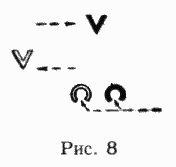
Male doll I, also with movement 2 “Razreden hod” turns, alternately back and front facing, to the L or R as he moves along a straight line to the L (Figure 8).
The two female dolls, as they perform movement 7 “Edna zad druga”, move forward one behind the other toward the “kaval player” (Figure 8).
Measure 33-40. Male doll II “plays” (Figure 9).
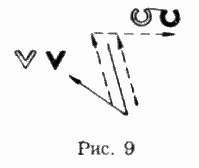
The two female dolls perform movement 7 “Edna zad druga” with which, positioned one next to the other, for the first four measures they move in the direction of female doll I, and for the next four turn, facing the audience, and as they assume a front basket-hold, they move to the L (Figure 9).
Male doll I—for two measures runs forward and passes between the two female dolls, in the third measure he squats and in the fourth with a jump up he turns to face male doll II. For the next four measures he repeats this, moving in the direction of the other male doll, finishing up facing the audience (Figure 9).
Measures 41-44. In the first measure the two male dolls squat. In the second measure with a jump up they straighten as the “kaval player” makes a complete turn in the air to the R. In the third measure they squat. In the fourth, male doll I, as he straightens up, swings his R arm out and “hooks” (catches under the arm) onto male doll II. Male doll II, as he straightens up, makes a half-turn in the air, swings out his R arm and “hooks” onto male doll I (Photo 11).
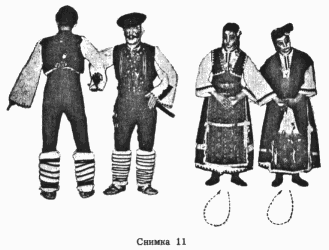
The two female dolls perform movement 8 “Horce” in an ellipse each in front of themselves, without disconnecting arms (Photo 11).
Measures 45-48. The two male dolls, “hooked” onto each other, pull on each other (try to unhook) on each first measure beat, without moving their feet. In the fourth measure male doll I shoves male doll II with his R arm and turns to face the audience (they unhook) (Photo 12).
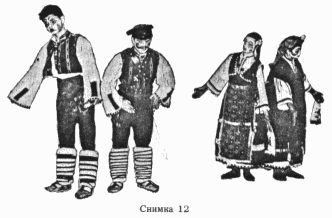
The two female dolls, without moving their feet, also try to disengage—they jerk their body and arms. In the fourth measure they let go and stop in position, leaning slightly forward (Photo 12).
Measures 49-52. All of the dolls stand in place two measures in position. In the next measure they jerk their bodies (without moving their feet). In the fourth measure they straighten up sharply. The female dolls place their palms on their stomachs with elbows out, and the male dolls extend their arms forward, bent at the elbows.
Measures 53-56. With movement 8 “Horce”, the dolls form a square. Some dolls perform the movement with back facing, others to the side, others forward, depending on which doll goes where (Figure 10). In the square, male doll II stops, facing female doll I; male doll I facing female doll II.
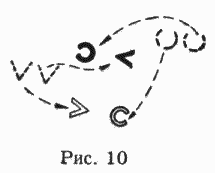
Measures 57-60. The female dolls, facing each other, perform movement 8 “Horce”, moving forward two measures and backing up two measures to their places (Figure 11).
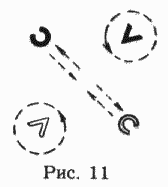
The two male dolls turn in place with tiny steps for three measures, and in the fourth measure facing each other, they perform the fourth measure of the movement 9 “Horce” (Figure 11).
Measures 61-64. All of the dolls move forward in a straight line (along the sides of the square) with movement 1 “Siten hod” for three measures, as they turn slightly to the L and R on each measure beat. In the fourth measure they turn with a jump to face the center of the square. The R arms of the female dolls are raised high in the air (Figure 12).
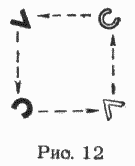
Measures 65-68. Everyone performs one measure “double čukče” in place turning slightly to the L and R, and one measure “triple čukče” also turning L and R. Feet are in first position; In the third measure they rise onto the toes of the R foot and make a half—turn to the L. (with back to the center of the square), L foot raised. In the fourth measure they step into second position.
Measures 69-72. All make a step forward with the R foot in the first measure, as the body turns to the R. In the second measure, L foot back, body to the L. Third measure—they rise high onto toes of L foot while making a half—turn to the R (facing center of square), L foot in the air. In the fourth measure they step into first position. The arms are bent up from the elbows and the palms, shoulder height, touch, as if they are preparing to dance.
Measures 73-76. In a circle the dolls perform; one measure “triple čukče”, one measure “double čukče”, one measure “triple čukče” as they turn slightly to the L and R. On “1” of the fourth measure, they do two čukče-s, and on “2” with a čukče they turn, backs to the center of the circle and raise their arms high.
Measures 77-78. All perform two measures “double čukče” with arms raised high.
Measures 79-80. Arms are still raised. The female dolls turn in place with tiny steps, and the male dolls pass by them with movement 1 “Siten hod”, male doll II in front of female doll I and male doll I in front of female doll II, and they stop on their L side (Figure 13).
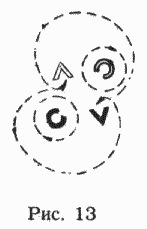
Measures 8l—84. For two measures the “couples”, bowing rhythmically, head off to the L and R sides of the stage with movement 1 “Siten hod” [(Figure 14)]. The R arms of the male dolls and the L arms of the female dolls are raised high and their fingers touch, as if holding each other, and the other arms are down and to the sides. In the fourth measure with a čukče on the L foot for the female dolls and on the R for the males, they turn towards each other and stop in second position.
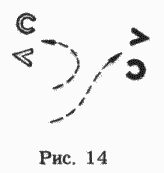
Measures 85-86 (transition). In the first measure the female dolls with a čukče on the L foot make a half-turn to the R—II facing and I with her back to the audience, and they step into second position, arms to the side. The male dolls do the same, except that they turn to the L, and their arms are bent at the elbows in a free-hanging position. In the second measure the female dolls with a čukče on the R foot make a half-turn to the R into second position. The male dolls do the same except that they do a quarter-turn to the L and stop facing the female dolls.
Measures 87-94. The two female dolls, moving in line of direction, perform movement 10 “vŭrtene po spirala,” and the male dolls rest (in position)(Figure 15).
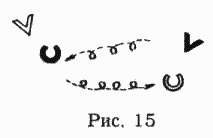
Measures 95-102. The female dolls turn to the L in place with tiny steps. Their L arms (handkerchief tied to the middle finger) are raised high, and their R arms are in front of the stomach with elbows out (Figure 16).
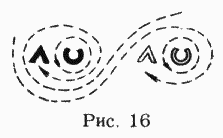
The two male dolls head towards “their ladies” with movement 1 “Siten hod,” circle them once and then come close to them on their R sides (Figure 16).
Measures 103-110. On “1” of the first measure the male dolls take the female dolls’ R arms with their R arms and turn swiftly in couples to the R (Photo 13).
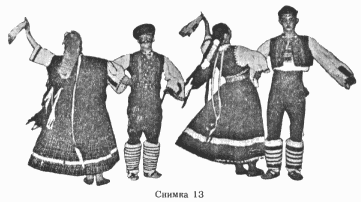
In the last measure on “one” the male dolls stop dancing and push the female dolls
with their R arms, which helps them to turn sharply in front of them. On “2” the
female dolls stop, lined up in a row with the male dolls, and they link L arms with the
male dolls’ R arms (Photo 14).
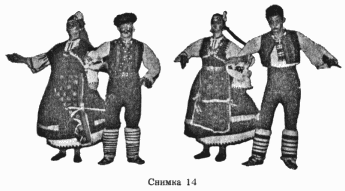
After a short pause they all bow “in a doll-like fashion”, then each doll one after the other, and after them the gŭdulka player carrying his stool exit downstage R.
Dance described by P. Rizova
Stage depiction of folk dances and the creation of new dances is a long, complicated and difficult process. The selection and basic study of the folklore material upon which a new dance is built is necessary. Great efforts are necessary in order to define the idea, form, movement, line, etc. After deciding on each of these elements, the dance, created in the imagination of the choreographer, first of all is expressed on paper—and here is a new problem. Oftentimes a dance visualized in the mind looks good, but when it is put on stage, weak places appear to a greater or lesser degree. This makes it necessary to make several attempts and “on the spot” corrections, which are aggravating to the performers. The choreographer must take this into consideration at times, but all in all the corrections are somewhat unavoidable. In this respect there must be a certain amount of explanation, especially amongst amateurs, because people often expect that the choreographer-director must always be “prepared”, even to present a new, untried dance without any changes. In such a case the choreographer cannot ever be completely prepared because he has no way to check his own work as, for example, a writer can reread and correct a work after he has written it, or a composer can play what he has written and listen to it. The best works in all areas of art and science are those achieved on the basis of much experimentation. Many famous artists and writers made dozens of sketches, drafts and rough copies before they produced their great works. This is why one cannot expect some sort of outstanding genius out of a choreographer. It is understood that he must try on his own to find the best working form of the dance so that he will make fewer changes while actually setting the piece.
Staging a dance that has already been worked out on stage previously is much easier. In such a case the choreographer-director can and must appear before the dancers completely prepared. Success depends above all on the savoir-faire, pedagogical capabilities and work methods of the choreographer. The choreographer-director first must study the dance carefully until he understands the character and specific movements completely. Then he figures out bow to explain the movements and present them in ordered diagrams. After mastering all of this he studies the separate parts of the dance and finally assembles the whole composition. In these circumstances the bulk of the work must fall mainly upon the correct mastery of the dance and its artistic and emotional presentation.
Especially useful are the meetings which are held with the performers before beginning preparation for staging, during and after the finalization of the dance. At such meetings one can make immediate appropriate notes and hear valuable opinions. Oftentimes many of the suggestions given turn out to be completely out of place, but sometimes one single thought can lead the director to a valuable idea. Besides that, the performers pay more attention through participation, and it makes them more creative. This is why such meetings must be practically mandatory. After careful evaluation of all that is said, the director can make certain changes, change the whole plan completely or change nothing at all. It is his right, since he is responsible for the staging.
To stage a dance successfully the choreographer-director and performers must work patiently with full, and mutual efforts and attention.
Of course, since each different dance is staged differently, it is not possible nor correct to give precise rules for staging. Nevertheless, from previous good examples we can extract and understand some basic rules, common situations and various approaches in the creation of staged folk dance. A previously successful endeavor can be a model for the correct method of staging, of observing the requirements of the stage, and for general rules of all forms of art, for the performers’ discipline, consciousness and creative interrelations.
Here is how the dance “Kukli” was created, a dance included in the latest program of the State Ensemble for folk songs and dances. A folk dance of the same name was performed by the amateur dance collective from the village Kozičeno, Pomorie area /Black Sea coast/, at an exhibition of village amateur performances. Its form and movements were very primitive and poor. What made the dance attractive, however, was the performance, sincere and from the heart, as well as the comical aspect of the dancers as they imitated dolls. One man and one woman performed the dance without any sort of plot. From that moment the idea of a doll dance began to ripen. Recollections by gusla players with rag dolls, who traveled from village to village and festivals, helped in this respect. By pulling strings, with an appropriate song text and various statements directed at each doll (each who had its own name) such as “Shake, Deška!”, “Don’t get angry, Totka!”, “Play for them, Račko!”, etc., the rag dolls came to life with their own human characters, habits, weaknesses and attitudes. Researching this phenomenon was the first step. The movements had to be studied faithfully so that they could be developed correctly later and that new steps with tie same style and character could be created. In Kozičeno the dance was observed several times and recorded on film. The performers were questioned specifically under what circumstances it was danced, what meaning one or another movement had, and their answers, of course, were recorded. The folk-melody that the dance was performed to was recorded as well. After that a gusla player was brought to the ensemble, where he danced four dolls on a wooden trunk. He gave several “performances” for the entire dance ensemble.
The second step was the work of the choreographer on the whole concept. The concept, idea, impressions and research material that whirled in his head in a nebulous mass had to be translated into a clear form, into some sort of concrete, presentable plan. He had to decide how many dolls would dance, how they would begin, how the dance would develop and conclude.
The third step was a discussion of the piece with the ensemble, choosing performers and steps toward final performance. At this meeting there were no objections or special statements or opinions. The piece was approved and work began, first of all on the basic movements, performing as dolls, and only after that on the complete composition. Originally, it began with the simultaneous entrance of the four dolls, who moved right into a general dance together, which, even though it was varied in line and movement, was not satisfactory. The four dolls, who were supposed to represent four different characters, were somehow deprived of their individuality. The idea was not being brought across. This necessitated another meeting from which it was concluded that the dance still was not right. Work had to be cut short for a certain time so that it could be thought out more thoroughly, and the first attempts faded from memory.
After renewed efforts and searching by the choreographer the right dance was found. Now the dolls were presented one at a time, and through their relationships with one another they were as clearly defined as possible in a short 4-5 minute dance. The two quarrelsome neighbors who at the least provocation fall into heated dispute this time challenge their superiority before a “gallant suitor.” The sentimental kaval player puts an end to the quarrel. The power of the music pacifies the bickering women, calms everyone and unites them in a friendly dance. Only the basic movements were left from the first staging. It must be noted that for the attainment of a doll-like performance and doll-like movements great credit must be accorded to the performers themselves. It was much work from the very beginning, but no one protested, and everyone involved was pleased that a fine dance came out of it. It must be said that while the dance was being sought, so were the music and costumes. As a final result of the tight mutual work between the choreographer, composer, designer and performers, a dance that has already been completely acknowledged and established emerged.
M. Dikova
The successful staging of the dance “Kukli” depends above all on accurate foresight, the accomplishment of several difficult moments in the choreography and on the systematic and steady work of the choreographer-director and dancers. Putting together a doll dance does not mean that it should end up a masquerade of distorted, contorted beings, as has been the case.
The first job of the director, after he has become well acquainted with the description of the dance and all its supplementary notes, is to cast performers in at least two, or if possible, more than two casts. When casting, the character of the dolls and dancer capabilities must be kept in mind. After the establishment of the cast of casts, the performers must be acquainted generally with the dance, its content, each doll’s character must be explained, the character of the movements, costume, makeup, music, etc., must be established.
Most important to this dance is the “doll-like” performance. This is one of the difficulties of the dance. While other, non-doll, dances have fluid, free and full movements and facial expressions which make the revealing of the state of mind, thought., feelings or attitudes of characters easier, the expressive means in the doll dance are limited by sharp, tight movements, doll gestures and attitudes and a frozen facial expression. The lack of expressive facial animation presents not a small problem when the dolls must communicate, reveal their emotions and relate with the other dolls, but with a good imagination and a correct doll imitation the performance will be truthful and convincing.
All of the movements in the dance are performed with taut muscles. Especially important is that the neck be taut and that the head not move freely while turning in one direction or another, but that the whole body move as a unit.
Two female and two male dolls perform in the dance.
Female doll I in outer appearance is slender, tall, well-built and pretty. Her hair is pulled back smoothly into two braids, and she wears no headscarf. She is adorned with artificial flowers which project high above her head. She wears large earrings that, if made of heavy material, are tied to the ear with a thread so that that will not pull at the ear and cause pain. Base makeup is applied to the thread so that it will blend in. This doll is dressed in a long white chemise with long sleeves. Along the lower hem, sleeves, neck opening and small stand-up collar there is applied braid in which black dominates, combined with regional embroidery. Over the chemise is a long red overdress, plaid with black stripes. She wears a black regional apron, whose embroidery is emphasized with many colors, ribbons and lace for an overelaborateness suitable for a doll. At the neck opening in the back five or six multicolored ribbons are attached, which hang down the back below the knees. For jewelry one or two rows of large gold coins are placed across the chest, sewn separately and close to each other so that they will jingle while jumping. This is a mice addition of sound to the dance. The doll wears 3/4 green stockings with bright embroidery to which leather soles are sewn so that they will not wear out easily. On the middle finger of the left hand a small rectangular handkerchief is tied.
Confident of her beauty, the first doll behaves arrogantly, which often provokes the insults hurled at her. The insults and provocations never pass her by, and she is always ready to quarrel. The facial expression of this doll is one of a self-assured beauty.
Female doll II is short, stout and not especially pretty. She is dressed in the same manner as female doll I except that under her chemise a specially sewn stuffed pillow is placed so that she appears stout. The pillow is made like a vest with a deep neck opening and overstuffed bust. On the lower edge (around the waist) a thick stuffed doughnut is sewn with which the effect of a thick waist and stomach are achieved. The vest fastens in the front. Besides that, over the overdress a black garment with long fringe is worn. Her head is covered with a kerchief. It is also decorated with artificial flowers. She has earrings and coins like female doll I. Her stockings are the same as will, but their basic color is dark blue. She also has a handkerchief tied to her left hand.
In character she is a little envious, cantankerous and shrewish. She is especially bitter of the beauty of her neighbor. The facial expression of this doll is one with thin lips in a frown, flared nostrils and slightly frowning eyes that have a wicked glint in them.
Male doll I. Among male folk rag dolls a doll with a half village, half military costume is encountered most often. This dress presents the possibility for more extravagance and variance in the doll’s outer appearance, and the various hanging object. such as saber, dagger, fringe, brass buttons, etc., emphasize and add to the limited movements of the doll. This is why we will accept this doll as a “former sergeant”. He is dressed in a white shirt and thick black woolen trousers over which a long red cloth belt with varicolored fringes is wound. Over the shirt a red sleeveless vest with some applied braid is worn. He wears an old forage cap on his head. Across the chest and over the vest two straps with shiny buttons along them are worn crossed, and an old saber hangs from the belt. His legs are wrapped with thick puttees, which for ease in putting on may be made like leggings, lined with batting to achieve the thickness of the puttees which are very characteristic of the region that the original dance is from. Over the leggings leather peasant sandals are tied.
In character he is a vain, cowardly man who runs from responsibility; he likes to tease pretty girls and other men’s wives. This is why in the dance, during the two women’s quarrel, instead of interrupting and separating the women who are quarreling because of him, he watches them silently and backs off. The facial expression of this doll expresses his character: a vain ladies’ man, confident of his success with the women; he has curled up moustaches, a wily expression and a small smile.
Male doll II—the kaval player. In outer appearance he is slender and tall. He is dressed in a white shirt and thick black woolen trousers. He wears a red cloth belt with multicolored fringes. Over his shirt he wears a short red vest with braid appliques. He wears leather peasant sandals and low puttees. On his head is a “mushroom” kalpak / i.e. sheepswool hat, conically shaped and folded so that there is a depression in the top/. He holds a kaval /shepherd’ s flute/ in his hands which he plays at certain moments.
“He who sings can think no evil”. The kaval player is a good soul, of pure heart, honest and a good buddy. He intervenes in the women’s argument and helps to smooth it out.
His facial expression is that of a sentimental, clean, almost childlike soul. His face is round with inflated cheeks (without inserting fillers the performer himself inflates his cheeks and keeps them that way the whole dance; he breathes only through his nose). His eyebrows are arched high and express surprise, his eyes are wide open.
The facial expressions, makeup, costume and in general the entire external appearance of the dolls must be created with the characters to be portrayed in mind, the features of the face are drawn on—eyebrows, eyelashes and moustaches. Before applying base makeup the performers’ own eyebrows are soaped ever so that they will lie smooth, after that the base is applied, then rouge, which is applied in little circles on the cheeks, after that powder, and on top the new eyebrows, eyelashes and moustaches are drawn. Only the gŭdulka player’s moustache is of real hair.
In addition to the group of four dolls there is still one more figure—the gŭdulka player. Besides being the musician he is a participant in the dance. He leads the dolls on and off stage and throughout the whole dance watches them as if he is commanding them to dance at his will. He is dressed in a white shirt, brown heavy woolen trousers, a dark brown sleeveless vest buttoned up high in the front and he wears a dark brown or black cloth belt. On top he wears a flared overcoat, cut to the knees, the same color, as the trousers, with long sleeves and appliqued braid. He wears this garment unfastened. On his legs are thick puttees and leather peasant sandals, and on his head is a “mushroom” kalpak /see above/. He wears a large flower over his right ear, a rose or other kind. On his right side hangs a shoulder bag that bulges out a little. The gŭdulka player needs a low three-legged stool which he carries out himself onto the stage and at the end of the piece carries it back off.
The gŭdulka player is a smiling, good-hearted, merry and robust fellow in his later years.
While preparing the movements of the dance no great technical and rhythmical problems will be encountered. The difficult thing is, as previously stated, performing in a doll-like manner, keeping the muscles taut for the entire dance, which is very tiring. More difficult is the female dolls’ turning at the end of the dance. For this they need more extended and steady rehearsals. This movement is explained more specifically in the section “Description of movements” /movement 10/.
After preparing the basic and repeated movements in the dance, then comes the development of separate sections. The first section includes the accidental meeting e f the two female dolls and their, exchange of insults up to the entry of the “sergeant”. The second part includes the entry of the “sergeant”, the wooing of first one then the other female doll, and the renewed heated argument of the two female dolls up to the entry of the kaval player. The third part includes the entry of the kaval player up to the end of the dance. The dance finishes on the coda.
After putting together the entire dance, technical refinement of movement must be emphasized, as well as the establishment of believable behavior of the dolls between themselves, and of the gŭdulka player toward the dolls.
At the end of the dance bows are made in a doll-like fashion. Entry on and exit off stage for the bow or after the bow are also made in a doll-like fashion.
After the dance is ready, two or three rehearsals must be held on stage in order to adjust lighting, after which the piece may be performed in front of an audience.
From:
Biblioteka “Tancova samodejnost” 5
Državno izdatelstvo “Nauka i izkustvo”
Sofija, 1961
Translated from the Bulgarian by Rachel MacFarlane for “Radost” Folk ensemble.
Drawings from original photographs by Rachel MacFarlane. [These were not scanned or
used for this version -Ed.]
Seattle, Washington, 1983
Supplemental translations, editing and HTML formatting by Alexander Stoll.
Seattle, Washington USA, 1999.
I have chosen to transliterate Bulgarian words in a modified “academic” form with diacritical marks, treating them as a Slavic language written with Latin letters, such as Czech or Croatian. I have also chosen to refer to the dance movements with their Bulgarian names. This avoids some confusion, I believe, as many of the terms, such as “čukče” or “podrusvane”, for example, cannot be translated smoothly enough into English to withstand repetition in the dance description. I have also found it necessary to include occasional explanatory notes, which appear in the text enclosed in brackets.
When costuming this piece, please see Bŭlgarski narodni nosii, t. 2, by N. G. Veleva and Evg. Il. Lepavcova, Sofija, 1979; plate 81—woman’s summer festival costume from Kozičeno, Pomorijsko, and plate 84—man’s summer costume from Kozičeno, Pomorijsko, as well as the other plates and notes accompanying them for a more detailed description of actual regional costumes appropriate to this piece.
R. M.
The original draft copy of the translated text was scanned on a Hewlett-Packard Scanjet IIc flatbed scanner, using TextBridge Pro 98 under MS Win98. Some minor corrections of typos were made, and all images were enhanced and “cleaned up” considerably using ZSoft Photofinish 3.0 and L. Loureiro’s LViewPro 2.1. Passport Software’s Encore 4.1b was used to score the music and generate the MIDI sequences.
The entire MIDI sequence, amended from the score originally published (see note above) is given:
Omissions were corrected as well with additional translations as needed; these instances are enclosed by square brackets [...], with transliterated Bulgarian given as appropriate, followed by the editor’s translation. Basic HTML formatting and hyperlinks were also added to enhance readability and document “navigation”.
HTML-compatible UTF-8 based characters were employed for display of the transliterated
Bulgarian (as given in the table below) and for certain punctuation marks such as quotes
and apostrophes. The reader is responsible for configuring their browser to enable
correct display of this document. In particular the browser must correctly interpret
the header metatag:
<meta HTTP-EQUIV="Content-Type" CONTENT="text/html;
charset=UTF-8">
| Cyrillic | Latinized | English Approximation |
|---|---|---|
| Ж | Ž | “Zh” |
| Й | J | “Y” |
| Ц | C | “Ts” |
| Ч | Č | “Ch” |
| Ш | Š | “Sh” |
| Щ | ŠT | “Sht” |
| Ъ | Ŭ | “Uh” [Note: some obsolete HTML browsers cannot display this character “U Breve”.] |
| Я | JA | “Yah” |
A. S.
Not to be reproduced or transmitted without prior written permission of the Translator Rachel MacFarlane and the Editor Alexander Stoll Templeton.
© 1998-2006 Alexander Stoll Templeton